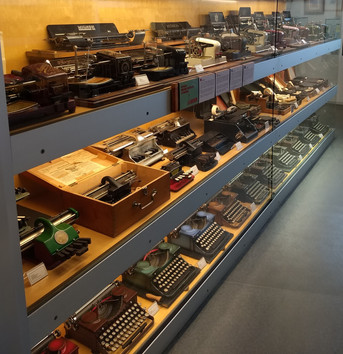Welcome (Back) to the Typewriter Gazette
- Typewriter Gazette
- Feb 9, 2019
- 3 min read

After the holiday started off with a surprise typewriter from my thoughtful (and funny) sister and her family (see above), I thought it might be nice to capture the typewriter cheer of the season with an an anniversary post. After all, it has been just over a year since we started this blog. As you may have noticed, it has already expanded into a full blown website, complete with interesting facts about the typewriters in our collection and picture galleries of our ribbon tin and adding machine collections. This year is bound to bring even further expansion. For one, we are slowly loading the rest of our typewriter collection, so come back every month or so for more pictures and interesting facts about these writing machines.

Last year we found ourselves in a small typewriter shop in Spain discussing the intricacies of typewriter restoration (which catalyzed this blog). This year we found ourselves in the not so small Museu de la Tecnica de l'Emporda in Figueres, Spain, discussing the excitement, and pains, of collecting with the owner. When events of the year concluded in our decision to trek back to Spain for vacation, we decided to book train tickets to Figueres, a Spanish city known for being the birthplace of Slavador Dalí. (Interesting fact: the Dalí museum was not only designed by the artist himself, but was built around his final resting place.) The city also happens to host an antique toy museum and the aforementioned typewriter museum. The toy museum, Museu del Joguet de Catalunya, contained many rooms full of toys from ancient times until today, which, of course, included three little tin toy typewriters. We also found a few of the tin toys made by BING Gebrüder; yes, the same company that made the BING typewriter!
Museu de la Tecnica de l'Emporda is a family-owned museum that contains the owner's collection of antique typewriters, grandfather clocks, sewing machines, check protectors, and many other household and office inventions of the past couple hundred years. (See their website at http://www.mte.cat/content/blogcategory/64/178/lang,ca/.) At the entry of the museum were many of these antiques from decades past, but the thrill for us was located on the top floor. When the elevator doors opened, we found ourselves in the middle of desks upon desks and shelves upon shelves of just about every typewriter we had ever read about. From Oliver to Sholes and Glidden, from almost all the colors of Royal and Corona portables to the rare Malling-Hansen Ball, we went from room to room taking in the collection. The owner had traveled 5,000,000 kilometers to acquire his collection of about 3,000 typewriters, 126 of which are Mignons. He said, with a bright smile, that they call him "Señor Mignon"!
By the way, not only did he have a Hansen Writing Ball with an English keyboard (left picture below), but also one with a rare moon alphabet!! Moon alphabet? What's that!? Read more about the moon alphabet at this link: https://www.omniglot.com/writing/moon.htm.
Typewriters seem to be making their impact all over Spain. An exhibit on technological

advances over the past couple of centuries revealed a telegraph remarkably like one of the earliest typewriters. A Sunday hunt in El Rastro turned up several machines we decided were a bit too large for our maletas. A man even sat in the middle of the market typing poetry for passers-by.
Picture above and on the right: Donated by French, H. A. (Glass Negative). (1947). Typewriter model. Washington, D. C.: National Photo Company Collection (Library of Congress). Retrieved from https://www.loc.gov/item/2016821938/.
On our way back, we pondered over how much typewriters have impacted history, and how much they are still impacting pop culture. They are turning up in TV shows, libraries, and coffee shops (the latter as a joke, or to grasp literary inspiration without the distraction of a computer). Typewriters aren't only for collectors, but are still being used by those who enjoy typing out a good letter, writing the next great novel or song, and to align an address on an envelope without having to mess with the automated templates that never seem to print out exactly where you expect them to. Somehow, it is comforting to know that these 100 year old machines still function the same way as when they were created, and yet we are still happy to have the conveniences of the modern smart phone. We believe that each machine has it's purpose, and are happy the typewriter hasn't been struck from society just yet.
We are looking forward to starting a new year of renovation and collecting, and hope you enjoy our finds and learnings as much as we do. Happy New Year, and welcome back to the Typewriter Gazette!




















Comments